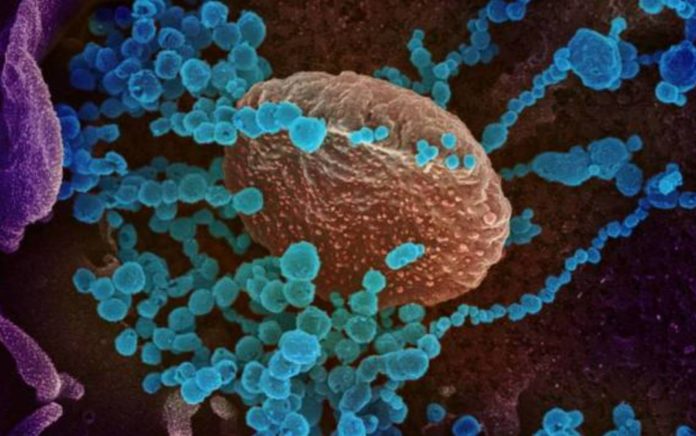A recent study could have solved one of the mysteries of the coronavirus: why it directly affects the lungs and how it gets access to its cells
The covid-19 remains a mystery. More than a year after the first cases emerged in China, which months later were exported to the rest of the world, scientists continue to work against the clock to try to understand how this virus was born and how it works, which already has more than 96 million infected and two millions of deceased worldwide. Understanding how SARS-CoV-2 works is essential to stop the pandemic and, after many efforts, scientists believe they have found one of the keys: the second ‘key’ with which it accesses the human body.
One of the great mysteries that this virus addresses lies, basically, in trying to understand how we get infected. To this day, we know that aerosols are the main route of infection, so coughing, sneezing, talking or screaming in closed spaces has become one of the main transmission factors of the virus, although, to a lesser extent, also it is transmitted by contact with surfaces. But knowing exactly how the virus grasps the human cell is essential to find tools that close those doors of entry to the body.
Several months ago, different scientific teams discovered the way in which the virus entered the body was through its glycoprotein S, the spike of the virus, which binds to the ACE2 receptor of the human body, beginning its contagion and reproduction in the human body. Although scientifically this reality is more than proven, the experts continued to wonder: if this was the entry route of the virus and the lungs were the main damaged organ, why is the activity of the ACE2 protein extremely low in them?
- Scientists in Fear of This New Predator From Red Sea Eating Native Species in Mediterranean
- Does This Mean We Stopped Being Animal and Started Being Human Due to ‘Copy Paste’ Errors?
- The One Lifestyle Choice That Could Reduce Your Heart Disease Risk By More Than 22%
- Aging: This Is What Happens Inside Your Body Right After Exercise
- Immune-Boosting Drink that Mimics Fasting to Reduce Fat – Scientists ‘Were Surprised’ By New Findings
Or, put another way, the experts knew that in that puzzle several pieces were missing and a fundamental one was to know why the lungs are so severely damaged when the main protein that infects the virus is practically residual in the respiratory tract. This situation has led scientists to be clear about one fact: in addition to the gateway that had already been confirmed, the virus had to keep another series of ‘keys’ that were responsible for generating the severe lung damage seen in many cases. Now, more than a year later, researchers may have an answer to the mystery.
Single-cell RNA sequencing data from 232,905 individual cells from major adult organs revealed that ACE2 is specifically expressed in the kidneys and digestive system, but rarely in organs such as the lungs and trachea. However, other studies indicate that there could be other important receptors and/or coreceptors in the host that allow them to bind to different elements of SARS-CoV-2 S and promote their entry into cells of the respiratory system.
Thus, a team of Chinese researchers believes they have found the second ‘key’ with which the coronavirus manages to penetrate the human body. As explained in a study published in the journal ‘Cell Research’, they have carried out a series of experiments with 22 different proteins with the aim of finding one in which the virus entered easily and was found in abundance in lung and bronchial cells. This research had a concrete result: the membrane protein AXL is as efficient for the penetration of covid-19 as in the case of ACE2.
“The level of expression of AXL is well correlated with the level of SARS-CoV-2 in bronchoalveolar lavage cells from patients with covid-19. Taken together, our findings suggest that AXL is a novel candidate receptor for SARS-CoV-2 which may play an important role in the promotion of viral infection in the human respiratory system and indicates that it is a potential target for future clinical intervention strategies. Furthermore, elimination of AXL significantly reduces SARS-CoV-2 infection in H1299 lung cells and in human primary lung epithelial cells,” the study explains.
- Scientists in Fear of This New Predator From Red Sea Eating Native Species in Mediterranean
- Does This Mean We Stopped Being Animal and Started Being Human Due to ‘Copy Paste’ Errors?
- The One Lifestyle Choice That Could Reduce Your Heart Disease Risk By More Than 22%
- Aging: This Is What Happens Inside Your Body Right After Exercise
- Immune-Boosting Drink that Mimics Fasting to Reduce Fat – Scientists ‘Were Surprised’ By New Findings
Without a doubt, this is an important advance in understanding how COVID-19 accesses our body. Knowing exactly how the coronavirus reaches human cells is essential to achieve an efficient remedy that ends this disease. For now, the membrane protein AXL points to important ways to be the second ‘key’ by which this virulent disease infects us. It could be the route of entry of the virus into our lungs and, in many cases, directly responsible for the most serious cases of covid-19.
